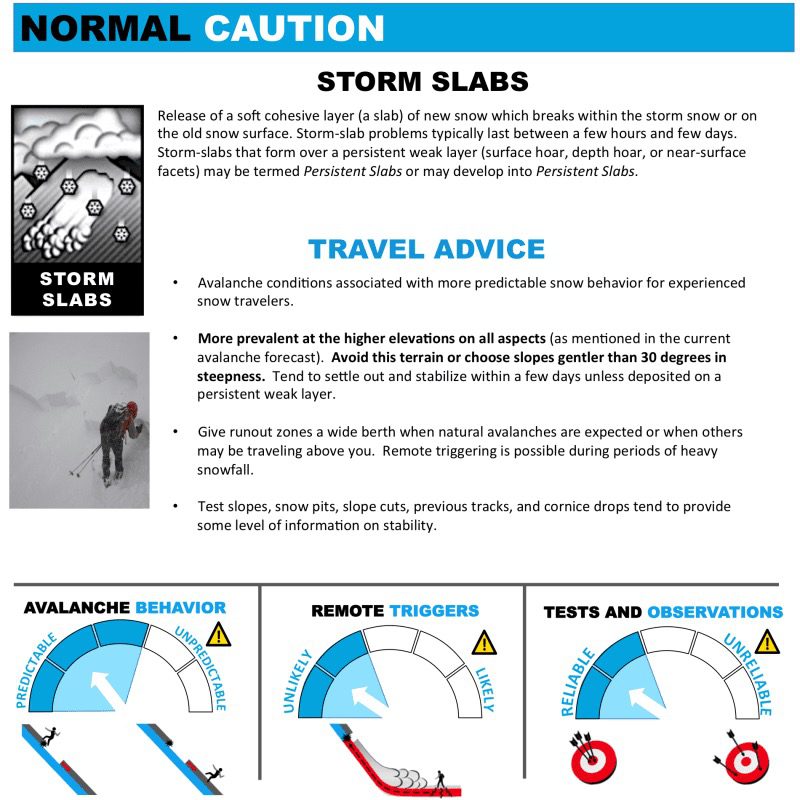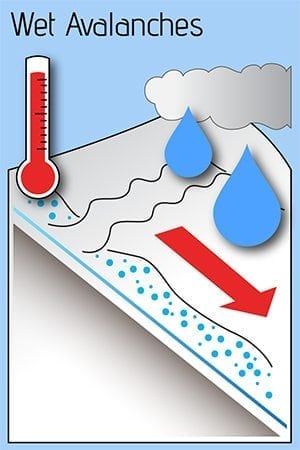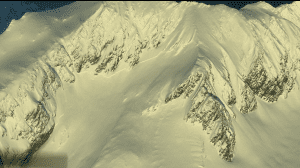Haines Avalanche Center
Above 2,500ftHigh
1,500 to 2,500ftHigh
Below 1,500ftHigh
Degrees of Avalanche Danger
Avalanche Problems
Problem 1

Aspect: All aspects, especially wind-protected basins, aprons below steep terrain (see photos in Avalanche Activity Section below)
Elevation: Treeline and above.
Bottom Line: Avoid all avalanche terrain! Rapid, heavy loading on a suspect snowpack is occurring. The last several days have produced a number of natural avalanches with wide propagation. The onset of this new storm could be enough to tip the scales. This problem will be difficult to identify with recent accumulations and new snowfall and heavy precipitation is adding more stress. Remote triggering is possible to common, even from mild terrain. Human-triggered avalanches remain possible 1-6′ deep and even to the ground in some areas.
The likelihood of natural avalanches in the alpine is increasing. Avoid run-out zones and significant avalanche terrain, especially in poor visibility. There were active layers during the last storm, and many slopes may be on the brink, waiting for a trigger.
Travel Advice:
- Limit travel in the alpine during heavy snowfall and increasing temperatures
- Think about any steep connected terrain and how a slab could propagate wider than expected
- Avoid similar terrain to the photos of recent avalanches (Avalanche Activity Section below)
- Look for recent natural avalanches.
- Watch for red flags: shooting cracks and collapsing (whumphing).
- Give a wide travel margin to suspect slopes, travel one-at-a-time, eyes on!
- Avoid terrain with traps and complexity.
- Use travel test pits to identify any suspect layers. Buried surface hoar is difficult to find in a snowpit without careful testing and shearing off layers.


Surface Hoar from Flower Mountain on 1/20/2022 & Buried Surface Hoar down 30cm and weak faceted layer down 100cm on 2/3/2022
Likelihood:
- Almost Certain
- Very Likely
- Likely
- Possible
- Unlikely
Size:
- Historic
- Very Large
- Large
- Small
Trend
- Increasing
- Steady
- Decreasing
Problem 2

Aspect: All
Elevation: Near and Above Treeline, or above the freezing level.
Bottom Line: Very heavy and wet snowfall is expected today, with accumulations approaching 13″ by tonight. South winds will be moving around the new snow, and temperatures will be hovering near freezing. Avalanches will be likely within the new snow. Wind loaded areas could accumulate enough critical loading to trigger deep persistent weak layers, which could cause wide propagation and very large avalanches that run full-path.
Travel Advice:
- Avoid all avalanche terrain! Stick to slopes less than 30 degrees.
- Asses for crack propagation potential, especially over convexities.
- If you head out, stick to the trees and watch out for terrain traps where even small slides could pile up to be quite deep.
- Stay out of avalanche runout zones along valley bottoms.
Likelihood:
- Almost Certain
- Very Likely
- Likely
- Possible
- Unlikely
Size:
- Historic
- Very Large
- Large
- Small
Trend
- Increasing
- Steady
- Decreasing
Problem 3
Aspect: All
Elevation: Below freezing levels ~2,000′
Bottom Line: The advent of this front is bringing in heavy precipitation, warmer temperatures, and rain on saturated snow. Anywhere at or below the freezing level, natural wet avalanches are likely. This includes the potential of liquid water loosening bonds not only at the surface, but deeper down on buried weak layers, or at the ground and could produce wet slab avalanches (see persistent problem.)
Travel advice:
- Travel in avalanche terrain is not recommended.
- With the nature of wet avalanches and the intensity of the incoming storm, no reliable travel technique through avalanche terrain will keep you safe.
- Avoiding any slopes greater than 25 degrees, connected terrain, and run out zones are vital to not getting caught in a potentially small to large slide.
- Be cautious of areas where terrain traps can turn small avalanches into deep burials. Dangerous conditions exist.
Likelihood:
- Almost Certain
- Very Likely
- Likely
- Possible
- Unlikely
Size:
- Historic
- Very Large
- Large
- Small
Trend
- Increasing
- Steady
- Decreasing
Avalanche Activity
From 1/29 to 2/1, several reports came in of recent avalanches in the alpine. The common characteristics of these slides were wide propagation, and failing 2-5ft deep at the interface below the wind slabs from last week’s atmospheric river. We have strong reason to suspect these slides occurred on a buried surface hoar layer from 1/20. They happened on all aspects, at elevations from 3000 – 5000ft, and all were in wind sheltered areas below ridges, features, and starting zones. Slide were observed in the Transitional and Lutak zones.
Weather
Forecast:
A quick moving moisture-laden front moved into the area yesterday afternoon. Through Sunday evening, this storm is expected to drop 1-3” of water equivalent precipitation. Multiple bands of precipitation will bring a prolonged period of heavy to moderate rainy on top of on already saturated snowpack. Snow levels will rise to ~2,000′. 8-16 inches of snow is predicted beyond 22 miles Haines Highway and areas above the freezing level. South winds gusting to the high 30s will accompany this storm.
Seasonal Summary:
- Feb 1st-4th brought in about 10″ of low density cold smoke powder
- Jan 27-29 brought 1.5 – 2.4″ of SWE with freezing levels near 1500ft.
- An Atmospheric river hit Jan 21-22. It brought in 2-7″ of SWE (2-5ft of snow above 2500ft, mostly rain below)
- Jan 9th-15th brought 24-48″ of new snow in the alpine, with some light rain up to 3,500ft, followed by heavier rain up to 2000ft.
- Very strong NW winds and arctic temperatures blasted the area the first week of January
- Jan 1st: New snow (20″ in Lutak, 7″ Transitional zone) buried any preserved surface hoar.
- Moderate NW winds hit exposed slopes Dec 19-20th
- Surface hoar formed on all aspects and elevations Dec 17-18th
- December brought in about 2-5 feet of snowfall (highest in Lutak zone), and a few strong NW wind events
- November brought consistent heavy snowfalls, cold weather, and SE winds
- October brought heavy snow in the alpine, followed by a few rain/sun crusts
| Snow Depth [in] | Last 24-hr Snow/SWE [in] | Last 3-days Snow/SWE [in] | Today’s Freezing Level [ft] | Today’s Winds | Next 24-hr Snow/SWE | |
| Mount Ripinsky @ treeline ** | 110″ * | 10″ / 1.0″* | 15″ / 1.5″* | 2,000′ | Strong, S | 13″ / 1.30* |
| Flower Mountain @ treeline | 73″ | 4″ / 0.08″ | 11″ / 0.90″ | 2,000′ | Strong, S | 13″ / 1.30 “ |
| Chilkat Pass @ 3,100ft | 30″ | 4″ / 0.08″ | 6″ / 0.30″ | 2,000′ | Mod, S | 11″ / 1.0* |
( *star means meteorological estimate )
** The Ripinsky weather station is in need of repair, and will likely be down until Summer.
Additional Information
Safe backcountry travel requires training and experience. You control your own risk by choosing where, when and how you travel. Ride rescue ready. Be prepared for an emergency. Prevent hypothermia. Carry bear spray. Winter is a high consequence environment.
Become a sustaining Haines Avalanche Center Member by clicking the poster or visiting dev.alaskasnow.org/joinHAC. Support local forecasts, observations, education and weather stations. Join a community of winter recreationalists. Benefit from collective knowledge and skills. Help keep your friends and family safe in the backcountry. Get a free limited edition mountain buff, or neck gaiter with a $50 membership (first 20 members!).
Practice like you play. Make sure all your rescue gear is fully functional and your beacon has NEW batteries. Make sure 1) everyone in the group has a functioning beacon, shovel and probe 2) knows how to use them and 3) has trained in companion rescue in the last year. Keep your skills fresh. If you head into the hills, watch out for red flag avalanche conditions, natural avalanches, whoomphing or collapsing, and shooting cracks.
Education Video Links:
- AIARE
- How to Practice Avalanche Rescue Snowmobile Edition: https://youtu.be/2ML499MMDfM
- AK Sled Shed Motorized Learning:
- Intro: https://youtu.be/aoagKHfGkxs
- Personal Electronics in Avalanche Terrain: https://youtu.be/2Vz9S0OEyFk
- Snowmobile Macgyver Tool Kit: https://youtu.be/4WBNu_t6Bbk
- Head and Face Protection: https://youtu.be/jIzW89wOyZI
- Pre-season prep: https://youtu.be/zJmrb8cZlR4
- My Transceiver: https://youtu.be/yblaDWP7Jf8
- BCA Avalanche Safety for Snowmobilers
- How to Fix Common Snowmobile Problems in the Field: https://youtu.be/g9fiTxEvuFk
- Sleducation: Avalanche Safety for Snowmobilers: https://youtu.be/EWFOd_9DYb8
- Intro to Avalanche Transceivers for Snowmobilers: https://youtu.be/6ZLSBmsceog
- Avalanche Transceiver Trailhead Test for Snowmobilers: https://youtu.be/rWoXbadFBsY
- Avalanche Transceiver Searching Use Snowmobiles: https://youtu.be/w1ucyI6LMXM
- BCA Avalanche Rescue Series
- Beacon Search 101: https://youtu.be/nnHXLVA2FcE
- Avalanche Probing 101: https://youtu.be/-0_yDN5Drzw
- Avalanche Shoveling 101: https://youtu.be/dGQg9o3vAkM
- Organizing a Backcountry Rescue: https://youtu.be/gywtmukgt8s
- Post Avalanche Patient Care: https://youtu.be/9FyIeUy4wpQ
- Backcountry Evacuation: https://youtu.be/WPF-dciefL8
- Complex Multiple Burials Backup Techniques: https://youtu.be/pB6AfY2KyYo
- National Avalanche Center
- Avalanche Problems Explained: https://youtu.be/DkbnT_9-cHU
- Intro to North American Avalanche Danger Scale: https://youtu.be/r_-KpOu7tbA
Announcements
Click the +Full Forecast button below to read the details. Please submit your observations if you head out!






